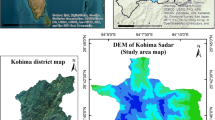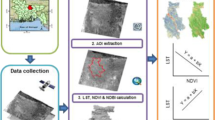Abstract
This paper focuses on interpreting the different spatial relationships between NDVI and T s, a triangular or a trapezoid, and on analyzing transformation conditions, the physical and ecological meanings of the vegetation index-surface temperature space as well. Further, we use the Temperature-Vegetation Dryness Index (TVDI) to explain the existent meaning of a triangular space after NDVI reaches its saturated state by employing the relationships between NDVI, LAI and evapotranspiration. The specific relations between NDVI and T s are useful for describing, validating and updating land surface models.
Similar content being viewed by others

References
Goetz S J. Muti-sensor analysis of NDVI, surface temperature and biophysical variables at a mixed grassland site. Int J Remote Sens, 1997, 18(1): 71–94
Carlson T N, Gillie R R, Perry E M. A method to make use of thermal infrared temperature and NDVI measurements to infer surface soil water content and fractional vegetation cover. Remote Sens Rev, 1994, 9: 161–173
Gillies R R, Carlson T N, Kustas W P. A verification of the ‘triangle’ method for obtaining surface soil water content and energy fluxes from remote measurements of the Normalized Difference Vegetation Index (NDVI) and surface radiant temperature. Int J Remote Sens, 1997, 18(15): 3145–3166
Sandholt I, Rasmussen K, Andersen J. A simple interpretation of the surface temperature/vegetation index space for assessment of surface moisture status. Remote Sens Environ, 2002, 79: 213–224
Price J C. Using spatial context in satellite data to infer regional scale evapotranspiration. IEEE Trans Geosci and Remote Sensing, 1990, 28: 940–948
Carlson T N, Capehart W J, Gillies R R. A new look at the simplified method for remote sensing of daily evapotranspiration, Remote Sens Environ, 1995, 54: 161–167
Moron M S, Clarke T R, Inoue Y, et al. Estimating crop water deficit using the relation between surface air temperature and spectral vegetation index. Remote Sens Environ, 1994, 49: 246–263
Jackson R D, Idso S B, Reginato R J, et al. Canopy temperature as a crop water stress indicator. Water Resour Res, 1981, 17: 1133–1138
Prihodko L, Goward S N. Estimation of air temperature from remotely sensed surface observations. Remote Sens Environ, 1997, 60: 335–346
Boegh E, Soegaard H, Hanan N, et al. A remote sensing study of the NDVI-Ts relationship and the transpiration from sparse vegetation in the Sahel based on high-resolution satellite data. Remote Sens Environ, 1999, 69: 224–240
Nemain R R, Running S W. Estimation of regional surface resistance to evapotranspiration from NDVI and thermal-IR AVHRR data. J Appl Meteorol, 1989, 28: 276–284
Le Jiang, Shafiqul Islam. Estimation of surface evaporation map over southern Great Plains using remote sensing data. Water Resour Res, 2001, 37(2): 329–340
Le Jiang, Shafiqul Islam. A methodology for estimation of surface evaporation over large areas using remote sensing observations. Geophys Res Lett, 1999, 26(17): 2773–2776
Lambin E F, Ehrlich D. The surface temperature-vegetation index space for land cover and land-cover change analysis. Int J Remote Sens, 1996, 17(3): 463–487
Wang P, Gong J, Li X. Vegetation-temperature condition index and its application for drought monitoring. Geomatics and Information Science of Wuhan University (in Chinese), 2001, 26: 412–418
Wang P, Wan Z, Gong J, et al. Advances in drought monitoring by using remotely sensed normalized difference vegetation index and land surface temperature products. Adv Earth Sci (in Chinese), 2003, 18(4): 527–533
Yang B, Pei Z. Definition of crop condition and crop monitoring using remote sensing. Transa CSAE (in Chinese), 1999, 15(3): 214–218
Jiang D, Wang N, Yang X, et al. Ecological connotation and application of the vegetation index-surface temperature feature space. Progr Geogr (in Chinese), 2001, 20(2): 146–152
Liu L, Zhang B, Zheng L, et al. Target classification and soil water content regression using land surface temperature and vegetation index. J Infrared Millim W (in Chinese), 2002, 21(4): 269–273
Gillies R R, Carlson T N. Thermal remote sensing of surface soil water content with partial vegetation cover for incorporation into climate models. J Appl Meteorol, 1995, 34: 745–756
Wan Z, Wang P, Li X. Using MODIS land surface temperature and Normalized Difference Vegetation Index products for monitoring drought in the southern Great Plains, USA. Int J Remote Sens, 2004, 25(1): 61–72
William P K, John M N, Martha C A. Estimating subpixel surface temperatures and energy fluxes from the vegetation index-ra-diometric temperature relationship. Remote Sens Environ, 2003, 85: 429–440
Nemani R R, Pierce L, Running S W. Developing satellite-derived estimates of surface moisture status. J Appl Meteorol, 1993, 32(3): 548–557
Kenlo N, Ramakrishna R N, Joseph M G, et al. Development of an evapotranspiration index from Aqua/MODIS for monitoring surface moisture status. IEEE Transa Geosci Remote Sensing, 2003, 41(2): 493–501
Nemani R R, Running S W. Testing a theoretical climate-soil-leaf area hydrologic equilibrium of forests using satellite data and ecosystem simulation. Agr Forest Meteorol, 1989, 44: 245–260
Carlson T N, Ripley D A. On the relation between NDVI, fractional vegetation cover, and leaf area index. Remote Sens Environ, 1997, 62: 241–252
Baret F, Guyot G. Potentials and limits of vegetation indices for LAI and APAR assessment. Remote Sens Environ, 1991, 35: 161–173
Choudhury B J, Ahmed N U, Idso S B, et al. Relations between evaporation coefficients and vegetation indices studied by model simulations. Remote Sens Environ, 1994, 50, 1–17
Chen Y, Li X, Shi P. Regional evapotranspiration estimation over northwest China using remote sensing. Acta Geogr Sin (in Chinese), 2001, 56(3): 261–268
Huang M, Shao M, Li Y. A modified stochastic-dynamic water balance model and its application, II. Model validation. Shuili Xuebao (in Chinese), 2000, 6: 27–33
Author information
Authors and Affiliations
Corresponding author
Rights and permissions
About this article
Cite this article
Han, L., Wang, P., Yang, H. et al. Study on NDVI-T s space by combining LAI and evapotranspiration. SCI CHINA SER D 49, 747–754 (2006). https://doi.org/10.1007/s11430-006-0747-0
Received:
Accepted:
Issue Date:
DOI: https://doi.org/10.1007/s11430-006-0747-0



